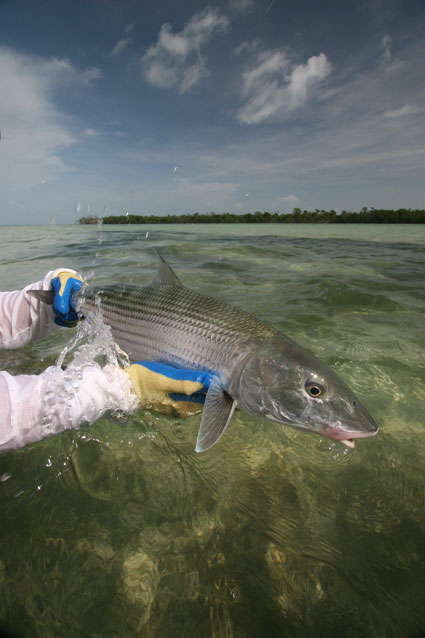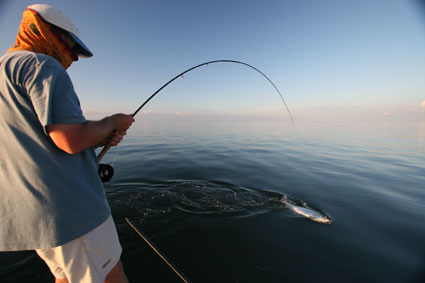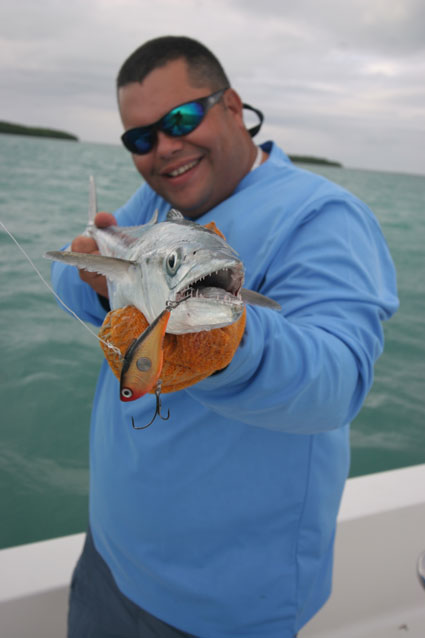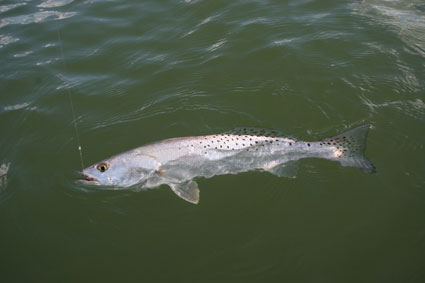November 10, 2015
By Jody Moore
Islamorada earned her place among bonefish and tarpon anglers, but today caters to a more diverse crowd.

Even the world's smartest bonefish make enough mistakes to please Upper Keys fisherman.
|
Recently I sampled the modern array of flats fishing possibilities out of Islamorada in the Florida Keys. I was on a two-day trip based at La Siesta Resort and Marina. The first day was windy, overcast and spitting a little rain—not the best weather for sightcasting for bonefish on the flats. Guide Juan Garcia, who runs a 22-foot bay boat, opted to fish some large mullet muds inside the Everglades National Park boundary in Florida Bay. I caught a number of ladyfish, some nice trout, some jacks, a couple of Spanish mackerel and a whopper of a cero mackerel that peeled an impressive amount of line off my reel. I didn't have a heavy bite tippet, but I was lucky to have hooked that cero in the corner of its mouth and therefore avoided a cutoff.
I had never fished the mullet muds in the basins behind Islamorada and was glad to learn of such a fishery.
Flats fishing in Islamorada has a long and colorful history, culminating in today's exceptional mix of fisheries.
The region's earliest heralded species, bonefish and permit, remain top targets 100 years after writer Zane Grey chronicled his catches while staying at the Long Key Fishing Club in 1910. Though Grey was an accomplished fly fisherman he wrote of catching bonefish and permit on conventional tackle—and both fish he found to be great tablefare. While there is considerable controversy over who caught the first bonefish on fly (some accounts place that catch as early as 1891), in 1939 Capt. Bill Smith used a fly made from a long hackle plucked from a chicken living on Islamorada. Flyfishing—and by extension other modes of flats fishing—really took off in this stretch of the Florida Keys after sportfishing writer Joe Brooks caught his first bonefish with Capt. Jimmy Albright in 1946 and had the photo to prove it. Brooks' articles featured in national outdoor magazines put Islamorada on the map as the saltwater flyfishing capital of the world.

Tarpon begin showing in April.
|
If there was a golden age to flats fishing on the “Purple Island” it would have to be the time from the late 1960s to the early ‘80s when fly tackle graduated from bamboo rods and waxed lines to fiberglass rods and vinyl covered lines to today's high-modulus graphite rods, clear and sinking lines and computer lathed bar stock reels. As tackle evolved, the exceptional fishing around Islamorada was promoted by legendary writers and anglers like Lefty Kreh, Stu Apte, Chico Fernandez, Flip Pallot and Billy Pate, to name a few. The variety and number of fly patterns exploded as anglers continued to chase tarpon and bonefish but also pursued the highly elusive permit and other species in the area such as redfish, trout, mackerel and snook.
While new fly patterns aren't popping off the vises every few minutes and the tackle isn't taking the leaps and bounds it once did, the fisheries are still there.

Spanish mackerel are dependable in the cooler months.
|
The notion of “educated” fish has crept into the vernacular, as some species, most notably bonefish and tarpon, have grown over the years more difficult to fool with flies and lures. And yet Islamorada remains one of the world's top destinations to catch 10-pound-plus bonefish. And the spring tarpon run offers unique access to oceanside as well as backcountry fish.
Flats fishermen visiting Islamorada have opened up to a host of other species found in the area, including redfish, seatrout, snook, mackerels, sharks, ladyfish and jacks.

Seatrout are also quite dependable in the cooler months as well.
|
Local guides like Garcia, in turn, understand the habits of fish and how conditions affect feeding patterns much better than 20 years ago. And, they have expanded their fishery beyond the nearby bonefish and tarpon flats to areas well into the adjacent waters of Everglades National Park and Florida Bay.
The second day of my “whirlwind” tour proved less windy but just as overcast and rainy. Captain Billy Ellenwood opted to take me back to some of his secret haunts deep in the middle of Florida Bay. Taking a convoluted trail that used unmarked native channels to cross the many flats, we arrived in an area surrounded by numerous unnamed islands. I was at loss as to where I was . . . which I believe was the captain's intention since he knew I was somewhat familiar with the area.
Poling close to the mangrove shorelines we came across a good number of redfish ghosting in and around the roots and just beneath the mangrove canopy. I'll chalk it up to angler error as to why we didn't connect with a red, but I did pull a few snook out from under the mangroves that I was able to sight cast to. Initially, the snook didn't respond to my subsurface fly, but when I switched to a deerhair slider that pushed a tantalizing head wake the fish couldn't resist. A couple of large schools of medium-sized jacks added to fun as they head waked to and around the boat on the flats that surrounded the islands.
Later, when the sun did appear, we headed back to Islamorada and fished the oceanside flats. Even though the water was high and on the final stages of incoming tide, we still found a few deepwater bonefish right next to the beach. The fish proved to be more curious than frightened and I was able to bring two boat side using a fast-sinking crab fly. Those two fish pounced on the fly quick.
It's trips like this that remind me why, any time I visit the Keys, I feel compelled to take just about every fly I own and half a dozen rods. There are just so many opportunities. For instance, I bring a variety of crab flies that will work equally well for bonefish, redfish and permit. I make sure to have plenty of slider-type deerhair patterns that work exceptionally well for snook, redfish
and tarpon for those calm, slicked-off mornings and evenings that I pray for. I will pack every Clouser minnow fly in ever color combination I own for all the species mentioned so far. I will also pack bonefish flies tied that I know will land lightly with little noise and disturbance specifically for shallow water tailers, as well has heavily weighted patterns for bonefish in 2 to 4 feet of water.

Redfish sight fishing turns on as spring winds abate.
|
Let's say it is the winter months of late November through March when cooler water temperatures prevail. I will take all the heavily weighted Clousers I have for seatrout and Spanish and cero mackerel. Why? Because one, there are plenty of trout and mackerel around during this time and two, they are two of my favorite fish to fry and put on the table. And, if there is a third reason, usually when you find trout and/or mackerel you find a lot of them and it sure is nice to have the fly line jerked out of your hand with just about every cast by the hammer-pounding strikes both these fish give. This year's cold weather had its effects, but populations of flats species survived well and will likely even see a regeneration bounce soon.
For the shoals of mackerel which gather in Florida Bay each winter, Clousers in pink and chartreuse seem to work best and I like to have both colors in case the fish are reacting to one shade over the other. I like my mackerel flies tied with artificial hair as opposed to bucktail since synthetic material holds up considerably better on the razor sharp teeth of mackerel. Trout react very well to bucktail Clousers tied in chartreuse-and-white, tans, browns and burnt orange. Anglers who favor jigs, soft baits or small floater/diver lipped plugs find luck in a similar palette of colors.
A great trick for finding both these fish is to look for and fish the mullets muds that you will come across in the grassy bottomed basins found between the islands and flats of Florida Bay. Some of these muds can cover an acre or better and the fish can either be found where the mud is the freshest where the mullet are rooting the bottom or on the edges where clear water meets dirty. Try different areas around a mud and allow your boat to drift downwind into a productive-looking area. When you do hit a productive spot be ready to stake off the boat so you can fish the area more effectively.
Besides using weighted flies for the muds I suggest using a sink tip or medium sinking fly line for this kind of fishing. Fly selection should be predicated on patterns that give a large silhouette. Keep in mind that for species like mackerel and ladyfish you'll need to employ a quick retrieve where the fly moves fast and stays close to the surface. Small seatrout are suckers for just about anything but for the big ones, Billy Ellenwood suggests employing a slow retrieve in the muds. Big trout often hang closer to the bottom. All three species can be found in clear waters as well, though they typically prefer a grassy bottom with comfortable depths of 4 to 7 feet.
Color selection for mullet muds depends on the clarity of the water. The general rule is use bright pink for really dirty water, chartreuse green for fairly disturbed water, yellow for mildly stained and white for clear water.
Jack crevalle and ladyfish will make for a number of hookups in mullet muds and if it happens to be summer or spring you can easily anticipate hooking up with a tarpon in mullet muds as well.
While on the subject of mullet muds, look for muds in shallow waters on the flats. Redfish are just as likely to be working the edges of mud as is the occasional snook. Target the smaller muds on the flats as opposed to major muds. In the fall months, always drop a fly on the back of the many stingrays that will be found creating comet-shaped muds on the flats. Redfish, jacks, bonefish and even permit and snapper are just as likely to be following a mudding stingray.
If you do get into the ladyfish or jacks think about saving a few if you want to tangle with a fish that can range from 30 to 120 pounds. I'm referring to what we euphemistically refer to as a “brown bonefish,” i.e. shark. A couple of ladyfish or a jack or even better a barracuda that is butterflied and strung over the side of the boat in waters that have a noticeable current. And as Ellenwood said, “With that kind of scent in the water the sharks are going to come. Use a big gob of a fly in red or orange. Sharks are a great fish to practice your big fish fighting skills on.” By “big gob of a fly” the captain means tying a fly by combining marabou, bucktail and saddle hackle in a large baitfish Deceiver type pattern. Where ever your fly lands when fishing sharks make sure the fly can be stripped directly past the shark's eye where the shark can most likely reactively turn and eat your pattern.
So, when you are planning your next or first flats fishing trip to Islamorada--besides your flies, prepare for every contingency in terms of tackle. Fly rod weights should range from 12 weights for tarpon and sharks, 8- and 9-weights for snook, reds, trout, mackerel and bonefish, to a 10-weight for baby tarpon and permit. Have at least one sinking line, and if you have only one fly rod make it a 9-weight. And finally, pack plenty of bite tippets in line classes of 40-, 60- and 80-pound test for sandpaper lips of tarpon, ladyfish and snook as well as light wire for the toothy mackerel, sharks and barracuda.
No matter the species you find in Islamorada, now matter how educated or naive, I think Billy Ellenwood sums it up best when he says, “Put the right fly in front of the right fish when he wants to eat it and you'll get a bite.”
FS Classics
